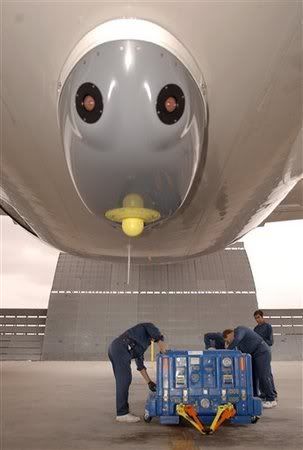The FedEx flight marked the start of operational testing and evaluation of the laser system designed to defend against shoulder-fired anti-aircraft missiles during takeoffs and landings.
Adapted from military technology, Guardian is designed to detect a missile launch and then direct a laser to the seeker system on the head of the missile and disrupt its guidance signals. The laser is not visible and is eye-safe, the company said.

"For the first time, we will be able to collect valuable logistics data while operating Guardian on aircraft in routine commercial service," said Robert L. DelBoca, vice president and general manager of Northrop Grumman's Defensive Systems Division.
During the current test phase, which concludes in March 2008, nine MD-10s equipped with the Guardian system will be in commercial service. Katie Lamb-Heinz of Northrop Grumman Electronic Systems said all those aircraft will be freighters. The ultimate goal is to defend passenger airliners.
The testing is part of the U.S. Department of Homeland Security's Counter-Man Portable Air Defense Systems program. BAE Systems has also been working for the government on a similar airliner defense system and has successfully tested it.
John Pike, a defense analyst at GlobalSecurity.org, an Alexandria, Va., think tank, suggested that development of the system was the lesser of issues for the airline industry.
"I think the problem is making the numbers work in the sense of figuring out who's going to pay for it," he said.
More than capital costs, airlines are likely to be most concerned about the costs of maintenance and aircraft downtime, he said.
"They've gotten these airliners now (so) that they are just remarkably maintenance-free. They've also gotten these airlines to the point that they've got razor thin margins," he said.
Sen. Barbara Boxer, D-Calif., viewed the plane Monday and said she was encouraged.
"This program is very promising because it's already met the operational testing. Now it's a question of how does it actually work in terms of stresses on the system while the airplane is in operation for several hours," said Boxer, a longtime proponent of equipping planes with anti-missile technology.
Boxer said her first priority is to equip the Civil Reserve Air Fleet, more than 1,000 commercial airplanes operated by airlines that contract with the Pentagon to make military flights during emergencies.
No passenger plane has ever been downed by a shoulder-fired missile outside of a combat zone. But terrorists linked with al-Qaida are believed to have fired two SA-7 missiles that narrowly missed an Israeli passenger jet after it took off from Mombasa, Kenya, in November 2002.
The first commercial flight with the Guardian system followed 16 months of tests on an MD-11, an MD-10 and a Boeing 747 using simulated launches of shoulder-fired missiles.
The Guardian system appears as a pod with eye-like features attached to the belly of the FedEx MD-10, a freight version of what was originally the three-engine widebody DC-10 airliner.
DHS gave Northrop Grumman and BAE Systems $45 million each in 2004 to adapt military defense systems to civilian airliners, requiring improvements because military systems need too much maintenance and mistakenly fire too often.
A government report obtained by The Associated Press last summer said that both the Northrop Grumman and BAE Systems prototypes still don't meet the reliability standards set by the DHS, and it could be 20 years before every U.S. passenger airplane has such a system.
Billions of dollars would have to be spent to protect all 6,800 commercial U.S. airliners.
The report said testing showed that the systems can be installed on commercial aircraft without impairing safety; at least one company can supply 1,000 systems at a cost of $1 million each; and operation and maintenance will cost $365 per flight, above the $300-per-flight goal.
Northrop Grumman said Tuesday that during the 16-month flight test program a ground-based "electronic missile surrogate" was used to simulate launches and each time Guardian functioned as designed, automatically detecting the simulated launch and mock missile.
"Had the threats been real, an invisible laser beam safe to humans would have disrupted the missile guidance system and protected the aircraft," the company statement said."




No comments:
Post a Comment